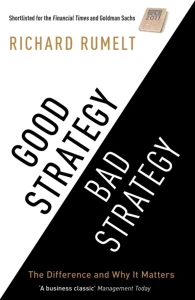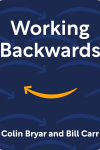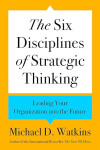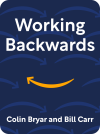Good Strategy / Bad Strategy
The difference and why it matters
"Good Strategy/Bad Strategy: The Difference and Why It Matters" by Richard Rumelt is a groundbreaking work that challenges conventional thinking about strategy in business, politics, and beyond. Rumelt argues that many organizations confuse goal-setting or motivational slogans with strategy, leading to what he terms "bad strategy."
In contrast, good strategy is characterized by its ability to focus energy and resources on one, or a very few, pivotal objectives, coordinating and concentrating action to overcome key challenges. The book introduces the concept of the "kernel" of strategy, consisting of three elements: a diagnosis that defines the challenge, a guiding policy for dealing with the challenge, and a set of coherent actions designed to carry out the guiding policy. Through numerous examples from business, politics, and military history, Rumelt illustrates how good strategy works and why it's so important. He also provides practical insights on how to develop and implement effective strategies, making this book an invaluable resource for leaders and decision-makers across all sectors.
If there was only one book that you have the time to read - make it this one
- "Competitive Strategy" by Michael Porter: A seminal work on industry analysis and competitive positioning.
- "Only the Paranoid Survive" by Andrew Grove: Explores strategic inflection points in business and how to navigate them.
- "The Art of War" by Sun Tzu: Ancient Chinese military treatise with enduring strategic principles.
- "Blue Ocean Strategy" by W. Chan Kim and Renée Mauborgne: Presents a framework for creating uncontested market space.
- "The Innovator's Dilemma" by Clayton Christensen: Examines why great companies can fail in the face of disruptive innovation.
Good strategy has a coherent structure called the “kernel,” consisting of three elements:
Diagnosis: This involves clearly defining and analyzing the challenge at hand. A good diagnosis simplifies the complexity of reality by identifying certain aspects of the situation as critical.
Guiding Policy: This outlines an overall approach for overcoming the obstacles highlighted by the diagnosis. It channels action in certain directions without fully defining exactly what shall be done.
Coherent Action: This involves a set of coordinated actions that work together to accomplish the guiding policy. These actions should be feasible, resource-efficient, and mutually reinforcing.
Many organizations confuse goal-setting or vision statements with strategy, leading to ineffective “bad strategy.”
Effective strategy focuses on overcoming a critical challenge rather than trying to solve every problem.
Good strategy often involves saying “no” to certain opportunities to maintain focus.
Strategy is as much about what an organization chooses not to do as it is about what it chooses to do.
Competitive advantage is not just about being better, but about being different in ways that are difficult for competitors to imitate.
Good strategy often stems from insight about a situation rather than extensive data analysis.
Diagnose Before Acting: Always start with a clear diagnosis of the situation before jumping to solutions.
Focus is Power: Concentrate resources on the most critical challenges rather than trying to do everything.
Coherence is Key: Ensure that all actions and policies work together towards the same goal.
Strategy is Choice: Good strategy involves making hard choices about what to do and what not to do.
Challenge Assumptions: Regularly question your own judgments and the prevailing wisdom in your industry.
Learn from History: Study historical examples of good and bad strategy to improve your strategic thinking.
Adapt and Experiment: Treat strategy as a hypothesis and be ready to adjust based on results.
What is the “kernel” of a good strategy?
The kernel consists of three elements: a diagnosis that defines the challenge, a guiding policy for dealing with the challenge, and a set of coherent actions to carry out the policy. This framework helps ensure that strategies are focused and actionable.
How does good strategy differ from bad strategy?
Good strategy focuses on the critical challenges a business faces and provides a coherent approach to overcoming them. Bad strategy often consists of vague goals, motivational slogans, or a list of desirable outcomes without a clear plan to achieve them.
What role does competitive advantage play in strategy?
Competitive advantage is crucial in strategy, but it’s not the same as financial gain. A good strategy seeks to deepen and broaden competitive advantages, create more demand for advantaged products or services, and strengthen isolating mechanisms that prevent others from copying the advantage.
Why are proximate objectives important in strategy?
Proximate objectives are feasible goals that are close at hand. They help simplify complex problems for the organization and provide clear direction, especially in dynamic and uncertain environments.
How should leaders approach strategy in dynamic situations?
In dynamic situations, leaders should focus on setting proximate objectives rather than long-term goals. They should also be prepared to adjust their strategies based on results, treating strategy as a hypothesis to be tested and refined.
What are some common pitfalls in strategic thinking?
Common pitfalls include mistaking goals for strategy, failing to focus and concentrate resources, ignoring the need for coherent action, overlooking the importance of diagnosis, assuming that growth always creates value, and failing to question one’s own judgments and assumptions.
How can organizations improve their strategic thinking?
Organizations can improve their strategic thinking by:
- Using tools like the “kernel” to structure their thinking
- Practicing the creation and destruction of strategic alternatives
- Developing habits of recording and reviewing judgments
- Focusing on understanding the past and present rather than just forecasting
- Cultivating proprietary knowledge and using it in strategy formulation
By reading “Good Strategy/Bad Strategy,” you will:
- Master the “kernel” framework for developing effective strategies, enabling you to create more focused and impactful plans in any context.
- Develop the ability to distinguish between good and bad strategy, helping you avoid common pitfalls in strategic thinking and planning.
- Gain insights into how to identify and focus on critical challenges, allowing you to allocate resources more effectively and achieve better results.
- Learn how to create and maintain competitive advantage by understanding the importance of being genuinely different, not just better.
- Enhance your strategic decision-making skills by learning to question assumptions, adapt to new information, and treat strategy as a hypothesis to be tested.

Your support helps me maintain and improve the book recommendations for everyone.






